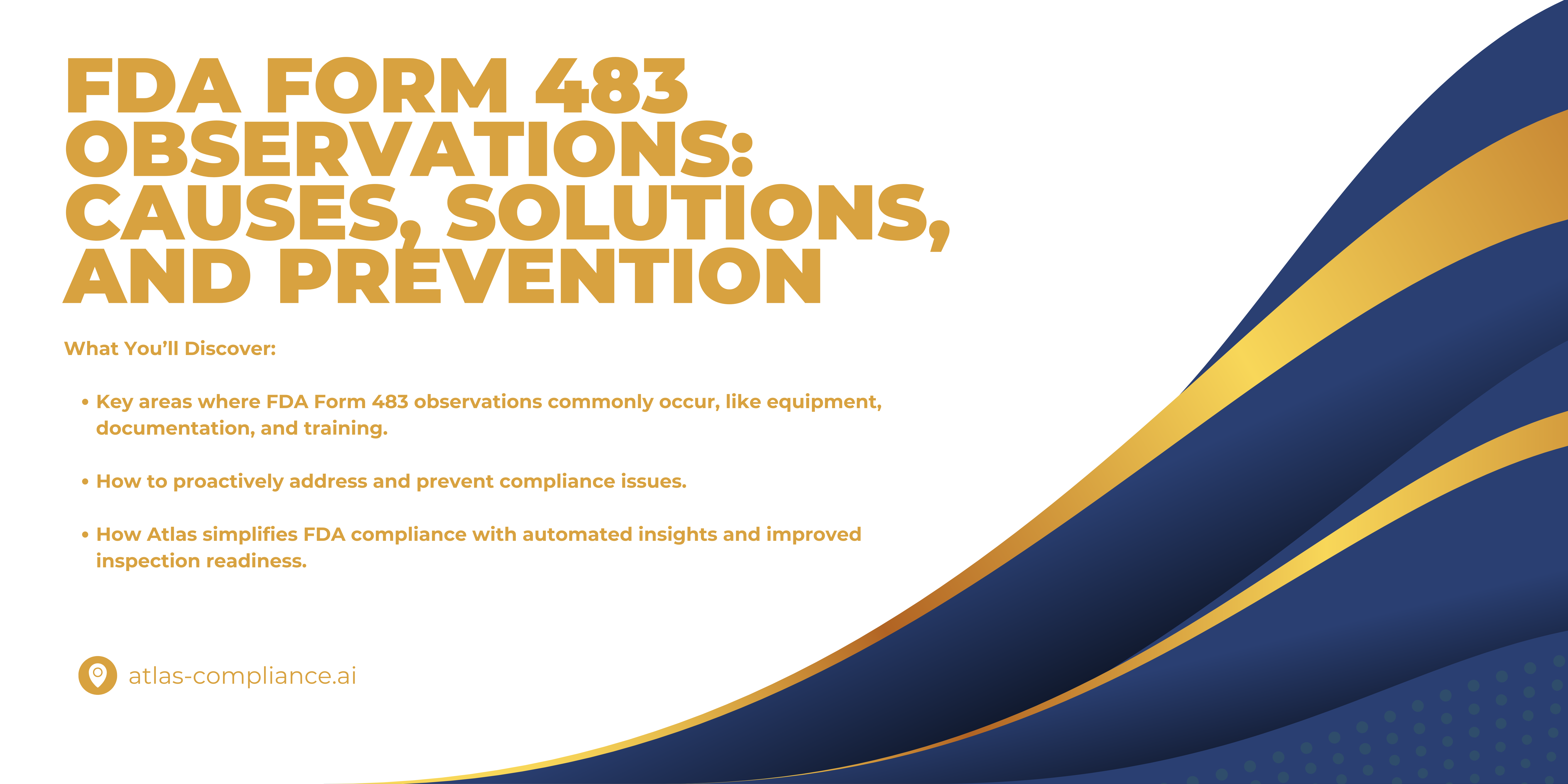tl;dr: FDA Form 483 observations highlight GMP non-compliance during FDA inspections. Common issues include equipment, documentation, processes, training, and facility controls. Prevent them through proactive management, strong documentation, training, audits, and compliance tools. Atlas simplifies compliance by automating insights and improving inspection readiness.

What Is FDA Form 483 Observations?
FDA Form 483 observations are official documents issued by the U.S. Food and Drug Administration (FDA) when inspectors identify conditions during an inspection that may violate the Food, Drug, and Cosmetic (FD&C) Act. These observations act as warnings, highlighting areas where a company’s practices fall short of regulatory requirements. They are not final enforcement actions but are meant to prompt companies to address and correct the identified issues promptly.
The goal of these observations is to ensure that facilities comply with Good Manufacturing Practices (GMP) to guarantee the safety, quality, and efficacy of their products. Companies must respond with a detailed plan to resolve the issues to avoid further actions such as Warning Letters or product recalls.
Common Categories of FDA Form 483 Observations
Form 483 observations can cover various aspects of a company’s operations. Some of the most frequently cited categories include:
1- Equipment Qualification and Maintenance Ensuring that manufacturing equipment is installed, operated, and maintained properly is a critical requirement. Observations in this area often involve:
- Improper Installation or Validation: Equipment is not installed or tested according to documented protocols (IQ/OQ/PQ).
- Inadequate Maintenance and Calibration: Regular maintenance and calibration schedules are either missing or not followed, which can lead to equipment malfunction.
- Use of Non-Qualified Equipment: Equipment used without proper qualification, risking inconsistent product quality.
Nearly 30% of observations in 2023 were related to inadequate equipment qualification and maintenance.
2- Documentation and Record-Keeping Accurate and complete documentation is essential for regulatory compliance. Observations in this area typically include:
- Missing or incomplete batch records.
- Inadequate documentation of cleaning, maintenance, or validation activities.
- Poorly maintained logs that fail to demonstrate compliance with GMP requirements.
- Around 20% of observations involve insufficient or incomplete documentation practices.
3- Process Controls and Validation Ensuring consistent production processes is essential for product quality. Observations may involve:
- Lack of validated manufacturing processes.
- Failure to monitor critical process parameters.
- Inadequate investigation and resolution of deviations.
25% of observations in 2023 stemmed from failures in process validation and controls.
4- Personnel Training Untrained or poorly trained personnel can lead to errors and compliance gaps. Common issues include:
- Lack of training records.
- Insufficient training in GMP standards and equipment operation.
Approximately 15% of Form 483 observations are linked to inadequate training programs.
5- Facility and Environmental Controls The manufacturing environment must meet strict standards to prevent contamination. Observations may address:
- Poor facility design or maintenance.
- Lack of proper air filtration systems.
- Failure to monitor environmental conditions like temperature and humidity.
Environmental and facility-related issues account for 10% of observations annually.
Root Causes of FDA Form 483 Observations
Several factors contribute to the issuance of FDA Form 483 observations, including:
- Inadequate Risk Management: Companies often fail to identify and mitigate potential risks in their processes.
- Resource Limitations: Budget or staffing constraints can lead to lapses in equipment maintenance, training, and documentation.
- Lack of Internal Audits: Regular audits are crucial for identifying and resolving compliance issues before an FDA inspection.
- Overreliance on Manual Processes: Manual methods increase the chances of human error and incomplete records.
How to Prevent and Address FDA Form 483 Observations
Companies can take several steps to avoid receiving FDA Form 483 observations and address them effectively if they occur:
Proactive Equipment Management:
- Conduct thorough qualification tests (IQ/OQ/PQ) for all equipment.
- Implement routine maintenance and calibration schedules.
- Use automated systems to monitor equipment performance and alert teams to issues.
Businesses that implement automated monitoring reduce equipment-related issues by 40%.
Strong Documentation Practices:
- Ensure all activities are documented clearly and comprehensively.
- Regularly audit records to identify and correct gaps.
- Train employees in proper documentation practices.
Companies with robust documentation systems improved compliance rates by 35%.
Comprehensive Training Programs:
- Develop detailed training modules on GMP requirements and specific job functions.
- Maintain up-to-date training records for all employees.
- Reinforce training regularly to address new regulations or processes.
Well-trained staff contribute to a 20% decrease in operational errors.
Internal Audits and Risk Assessments:
- Schedule frequent internal audits to uncover potential issues.
- Conduct risk assessments for all critical processes and address vulnerabilities proactively.
Companies conducting regular audits reduce compliance risks by 25%.
Leverage Compliance Tools:
- Utilize technology platforms to track, analyze, and respond to compliance risks.
- Engage with industry experts to stay updated on FDA trends and requirements.
Digital tools improve inspection preparedness by up to 50%.
Atlas makes FDA compliance simple by turning complex data into easy-to-understand insights, helping life sciences businesses stay on top of regulations. We support quality and regulatory teams by saving time, cutting down on unnecessary work, and letting companies focus on growing their business. By analyzing past inspection data, Atlas helps businesses learn from others’ mistakes, catch potential problems early, and prepare better for inspections. With Atlas, staying compliant becomes easier and less stressful.
Stay confident and compliant partner with Atlas today!
I got this site from my friend who told me on the topic
of this site and at the moment this time I am visiting this web site and reading very informative articles or reviews at this
time.
Sweet blog! I found it while browsing on Yahoo News. Do you have any suggestions on how to get listed in Yahoo News? I’ve been trying for a while but I never seem to get there! Appreciate it